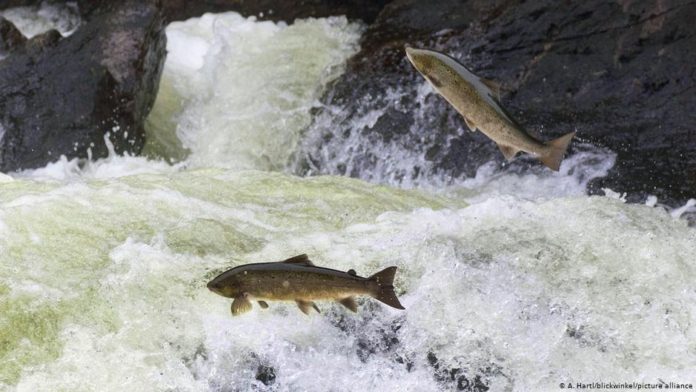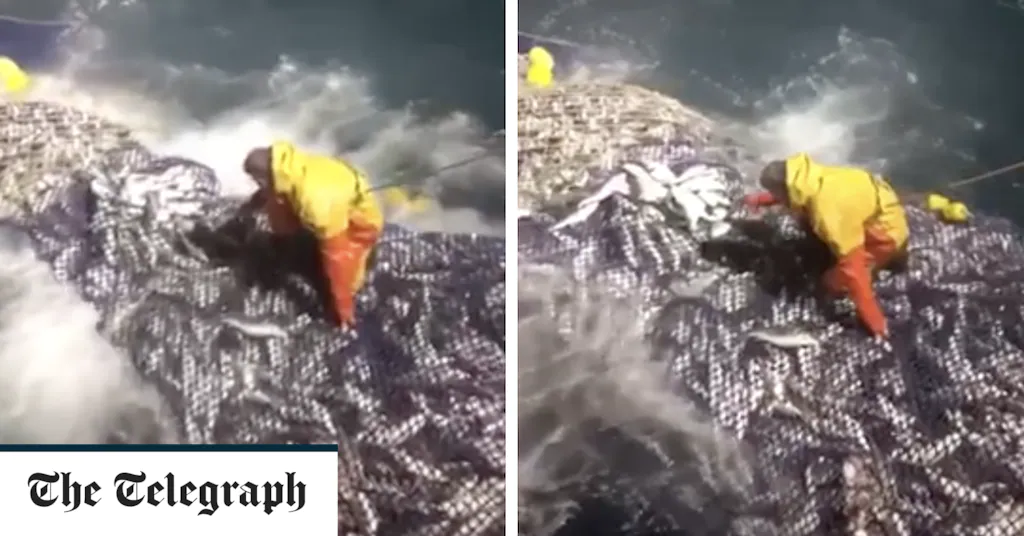James Mackay is 67 years old. He started work as a salmon netsman in Sutherland, on the north coast of Scotland, when he was 21. With his crew, he would harvest around 3,000 wild salmon in a season, using traditional techniques that had changed little in centuries. “It was like a historical heritage that was going on in the community for many years,” he says.
A great many years, judging by archaeological excavations on the flood plains of the River Dee in Scotland’s Aberdeenshire. Archaeologists believe hunter-gatherers camped here 7,000 years ago to make use of the fish the river provided.
And fisherfolk haven’t been the only ones to thrive on its rich stocks.
“Salmon have been incredibly important in our history for the sustenance of Scottish people,” says Edwin Third, operations manager for the River Dee Trust. “And so many other animals rely on them, from seals to fish-eating birds to freshwater pearl mussels. They were once such an abundant resource and fed so many things.”
Edwin Third, operations manager for the River Dee Trust, canoeing the River Dee through a section of native broadleaf forest
Salmon facing multiple threats
Yet in 2015, netsmen like Mackay were banned from their trade because of declining Salmon numbers.
Stocks are monitored by observing the number caught by anglers, who still fish here for sport, even though they are obliged to throw back any salmon they catch. The year 2018 saw the country’s lowest catch since records began in 1952, and last year, Fisheries Management Scotland warned that wild salmon were approaching “a crisis point.”
Mackay believes that the netsmen have been unfairly targeted for the much greater problems that are affecting salmon across the globe.
Read more: Europe’s seas to lose almost a third of life due to climate change: report
The fish are suffering a wide range of impacts in both their ocean and riverine habitats, including overfishing, the damming of rivers, pollution, parasites and other diseases originating in industrial salmon farms, and a warming climate.
But on the River Dee, Third believes the loss of Scottish forests is partly to blame. Which is why he’s managing a project to reforest parts of the Dee’s catchment.

An angler fishes at the opening of the salmon fishing season on the River Helmsdale. Anglers must throw back any salmon they catch
A special relationship between fish and trees
Thomas Reimchen, a biologist at the University of Victoria in Canada, was the first to document the intimate connection between salmon and forests. Researching the relationship between black bear and salmon on Canada’s West Coast in the early 1990s, he realized how nutrients the fish gathered from the oceans were nourishing plants and animals far inland.
“I would follow those bears as they moved back into the forest and I would sit back and they would eat what they wanted… and they would leave the rest,” Reimchen says. “And immediately, as soon as the bear would finish, within seconds, the crows — flocks of 100 to 200 crows would come.”
Read more: Forest SOS: Earth’s green lungs disappear
Half-eaten salmon carcasses provided sustenance for many other mammals, birds and insects. Maggots broke the salmon down so that the soil around spawning streams had higher levels of carbon, nitrogen and phosphorus than those of commercial grade fertilizer.
So enriched was the soil with nutrients from the fish, Reimchen even found evidence of particularly good year for salmon runs in tree rings.
And Third says that just as trees can benefit from salmon, so salmon in turn benefit from trees. Fallen leaves attract the aquatic insects the juvenile fish feed on. The nutrients that leach from organic debris even make their way to the ocean, where they nourish the growth of plankton that make up the salmon’s marine diet.
Logjams in rivers, meanwhile, provide the sheltered waters that salmon need to spawn. And the shade cast by riverside trees keep the juvenile fry cool.

Salmon discarded by bears in Canada rot into the forest floor enriching the soil, so that good salmon-run years even show up in tree rings
Keeping cool in a warming world
Salmon suffer stress in waters warmer than 23 degrees Celsius (73.4 degrees Fahrenheit), and as the climate warms, Scotland’s unshaded upland streams are hitting record temperatures. In 2018, the Gairn, a tributary of the Dee, reached 27.5 degrees, damaging young salmon stocks, according to the River Dee Trust.
Read more: Scotland restores its peatlands to keep carbon in the ground
According to NatureScot, Scotland’s Nature Agency, only 4% of Scottish land still retains its native woodlands. With temperatures only expected to rise, the Trust sees planting trees as key to keeping salmon breeding grounds safe for the young fish.
“We’ve got 300 kilometers (186 miles) of river really in danger and we need trees in now,” Third says. “We should have actually had trees in 50 years ago, but we didn’t have a crystal ball.”
Traditionally, Scottish estates manage their land for deer and grouse, and it can be hard to convince landowners to plant trees. But catch-and-release fly-fishing is also popular on the estates and Third says landowners are increasingly keen to work with the Trust as they realize the future of salmon is at stake.

Native trees including birch, willow, alder, rowan and Scots pine have been planted on a tributary of the River Dee to provide shade during increasingly high summer water temperatures in upland streams
Reviving the riparian ecosystem
“When I first started 20 years ago you could drive for miles and not see a single tree,” says Third. In the past five years the Trust has planted 200,000 trees on the upper stretches of the Dee; their eventual target is a million. “Now I can see our trees from Google Earth,” Third says. “That’s a great satisfaction.”
Read more: Oceans key to solving climate crisis, say world leaders
The salmon that hatch in the Scottish Highlands face a long and dangerous journey out into the ocean and back before they make it home to breed. But the River Dee Trust hopes that by caring for the whole river ecosystem, it can give them the best start in sheltered, nutrient-rich waters.
“Salmon are really resilient,” says Third. “And I think if we give them a bit of room, we can get them back in far more abundance than we’ve seen, not just in the last few years, but in the last 50 years. The alternative just doesn’t bear thinking about.”
Credit: Source link







































